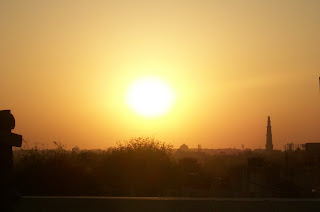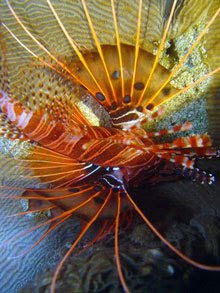I've written about teaching in Mayapuri in my blog before. This post is meant as an update. This is my second time teaching the wonderful kids at Mayapuri, and I've enjoyed it even more than last year.
As before, my classroom consists of a room with a tiled floor, on which mats are placed for the students and I to sit. There are no desks or chairs. We are all in bare feet. There is a whiteboard on the wall, and that's about it. Everything else that is used in the classroom is provided by me - pencils, paper, copy books, whiteboard markers, sharpeners, erasers and so on. Luckily, all these things are fairly cheap in India, so even providing all resources for 25 students only costs me an average of about Rs 50 (about $1) each each day.
The classroom was recently painted by a team from Ramsgate in the UK, so if you compare the photo to the ones from last year, you will see it's a lot brighter and fresher this year. The photo shows my intermediate level class doing a worksheet, being helped by Katie. Katie is an English Teaching Volunteer (ETV) in the Jeevan Nagar slum. We've started an informal program to visit each other's classrooms, and Katie was visiting on the day I took this photo.
The photo below shows the computer room, which is adjacent to my classroom. Asha believes that the keys to success in leaving the slums are knowledge of English and computers. Needless to say, for the students in a slum, this is the only access to computers they have, so it is a huge benefit to them. Part of the time the kids just goof off on the computers, like anyone else, watching Bollywood songs on Youtube and googling interesting images. However, many of them work hard to improve their skills. In the photo, the boy in the blue shirt with yellow shoulders is Adesh, and he is teaching himself to touch type. You'll see that his eyes are on the screen but his fingers are on the keyboard. His current typing speed in English in 40 words per minute. Not bad!
The number of students attending English classes has slowly increased, and the level of ability has also spread. Some kids are really quick to learn, and others not so much. So I have now divided my students into three groups, unimaginatively named Beginners, Intermediate and Advanced. In some ways, this has made my life busier, but in other ways it has made it more relaxed.
I now have to prepare lesson plans and resources for three separate classes every day. This is not just a matter of dreaming up what I'm going to teach and jotting down a few notes. Each lesson plan has to be a complete item, with explicit instructions to the teacher and a list of resources required. I then have to make those resources, such as worksheets, tests, song lyrics, vocabulary lists, and so on. This is because I have written the curriculum for all English teaching at Asha , and now I am writing all the lesson plans to go with them. The idea is that new ETVs will receive the lesson plans and resources when they arrive, so that they don't have to re-invent the wheel, and also to ensure some sort of continuity between volunteers. I love the teaching part, but writing all the detailed lesson plans is a bit tedious. However, we have a new ETV called Jenna who has just started teaching at Dr Ambedkar Basti, and she is using the lesson plans. Her feedback has been very positive, so that's encouraging.

Dividing my classes into three has created more work because I now have to write lesson plans for three parts of the curriculum simultaneously, but it has been more relaxing teaching smaller groups of kids, with a more-or-less similar ability. No-one is left behind because they can't understand the lesson, and similarly, no-one is bored stupid because they've learnt it all before. With about ten students in each class, they are much easier to manage, and we all seem to enjoy it more. The photo shows me at the start of a class (today, in fact) when only three students had arrived. These are some of the intermediate boys.
The hardest part was when I initially made the change, trying to explain to the boys that the division was based on English ability, not age or school grade. I kept getting confused boys asking why so-and-so was in this group at the Asha English class, but they were in the same grade at school. Indian schools are extremely rigid and hierarchical, so the idea of streaming by ability was clearly a new one to them.
The kids I teach are extremely motivated, and I've written before about the appalling conditions in which they live. So even though it's 40 degrees every day, and the ceiling fans only work half the time because we only have electricity half the time, and there are no resources and little support, I keep coming back because of the kids. They are so inspiring, and so keen to improve themselves and find a way out of the slum, that it makes all the effort worthwhile.












